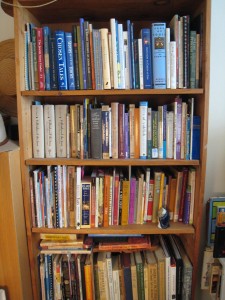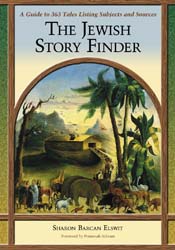“I discovered these books at the publisher’s (McFarland) vendor table at the American Folklore Society Annual Meeting… and wanted to share them as two great resources to start the new school semester, term, whatever term applies to those of you in the education system as student or professor.” Heide Anne Heiner, SurLaLune Fairy Tales Blog, 2011
Why? Teaching values are important in a school, and the first Story Finder grew as a

- Where, oh where, is that funny story about the man who speaks in signs and wins when the other person totally misinterprets what he is saying? There’s a Korean version and also one that’s Jewish here…somewhere..
tool for me. Teachers would run into the library for a story to address a problem – whether it was trying to stop tale telling or encouraging a student to take a chance out of his comfort zone. Picture books were easy to find using the library catalog, but some of the most novel stories are hidden away in collections. I’d have just the right story, if… now, where was that story of the talking cat who guides a midwife home at night and then shows up again as a demon asking her for a favor in return?
There was no guide to those folktales within collections. The scholarly Thompson Motif Index classifies folklore according to other criteria, such as the wicked stepmother, but this is not how educators need to find a story. They look for stories on building community, cautioning against selfishness, on the importance of ecology, and respect. Oh, Peninnah Schram and Howard Schwartz have all of the Jewish stories at their fingertips, but I could not keep calling.
Beginning: Originally, I sat down with one giant collection, but it just seemed tedious to catalog story by story, and I abandoned the project. Two things kept nagging at me. I still needed this story-finding tool and thought others could use one, too, and I wanted some of the culturally rich Jewish folktales I loved to be included in mainstream school studies of multicultural stories. After all, second grades around the country examined all the different variations of Cinderella from around the world; why not put the Jewish versions out there so they could be included?
Beginning Again, Better: Two years later, I sat down with piles of books everywhere and plunged in again, only choosing my 363 favorite stories this time. I filled notebooks story by story, book by book. I needed to differentiate between the appearance of my main story in other places and different versions of the same tale. One story could have many subjects it might belong to. And what defining words should I choose? Here, my mother was always ready to help evaluate the subtleties between alternatives, like Lies or Deceit. Other useful terms suggested themselves as I went along, and I needed to revisit each story to add these new words in. There was much to juggle.
I gathered different versions of stories together as I worked. And larger categories began to suggest themselves: holidays, animal tales, stories with magic, supernatural tales. These became the major chapter groupings. Because they grew generically from the culture of the stories, The East Asian Story Finder is divided into totally different chapters than The Jewish Story Finder. And just as in the library where a book may have many handles, but only one place where it might be shelved, so a story could have several applications, depending on the angle you were looking for.
I assigned each story many relevant subject terms, which I called Connections. These became the Subject Index for the Story Finders. A friend, Kathleen Meulen, from the Hudson Valley Library Association suggested that I work with Nota Bene software, to generate the indexes and bibliography. She had been using it to create a catalog for her church library, and so I did.
I wanted the Story Finder to be useful in many ways. Sometimes a person remembered the name of a story, so I created a Title Index, too. (Originally there was also a Geographic Index, but my editor at McFarland, suggested we incorporate places into the Subject Index.)
Heart in mouth, I shared this venture-in-progress with the award-winning storyteller Peninnah Schram, who not only gave it her enthusiastic blessing, but offered to write a foreword introducing Jewish folklore. Hooray!
Halfway There: When the book was almost half done, I sent the table of contents, a couple of sample entries, and sample index pages out to nine publishers of nonfiction. Three expressed interest, and by spring I decided to go with McFarland & Company, Publishers. Because the indexed stories were my favorites, I called the book Sharon’s Guide to Selected Jewish Folktales. Absolutely no one wanted me to keep my name in the title. But still, the Finders are personal and selective. I cannot include a story I would not myself tell or share with an audience.
Done! And so, in 2005, The Jewish Story Finder was born. I was thrilled when it won recognition from the Association of Jewish Libraries, with a special mention in bibliography in 2006. By 2007, I had begun work on The East Asian Story Finder, another favorite body of tales, which was released in 2009. Then McFarland asked me to expand The Jewish Story Finder. So much had changed with Internet access since 1st edition, where I had not included out-of-print books. Why point the way to books people would not be able to find? But now they could, and whole stories were appearing online. Not only had more collections been published in the eight years since I’d sent the first Finder off, but I discovered tales which resonated with me from some of the older books, too. And so, in 2012, the 2nd edition of The Jewish Story Finder arrived to point the way to 668 tales.
And then, a school library colleague pressed that she could really use a guide to stories from Latin America….I spent three years researching at NYPL’s Schwarzman Library at 42nd Street and their Schomburg Center in Harlem, plus tapping books from the MidHudson Library System’s collection. And in 2015 it all came together. There were so many decisions to make along the way, beginning with how to define Latin America, which took over one year….there were so many countries each encompassing many different cultures within. The Jewish Story Finder also ranged across many lands and back to ancient times, but a single religion there was a unifying factor. Mexico, Central America, and South America alone included 21 countries with very different people and identities, even within each country. There were indigenous populations to study, with layers of European, African, and Asian newcomers, some arriving as conquistadors, some as servants, some as slaves. So as not to be overwhelmed, I separated the islands of the Caribbean with all of their different cultures and languages for another Finder. And then there were issues of terminology – almost all books published before 1970 referred to the indigenous population as “Indians.” And many, many books were out of print. Why point the way to stories which no one would be able to get hold of? The Preface to The Latin American Story Finder addresses some of the considerations, and Heidi Ann Heiner has invited me to create a guest blog for SurLaLune Fairy Tales about creating this book, which will cover more.
Never Done: That’s why, too, I have created this blog. New books will come out tomorrow which may fit as variants under an existing title; new stories will be posted online. Now I have a living way to post this information as it happens and for you, too, to share in the conversation about relevant resources that are out there.

